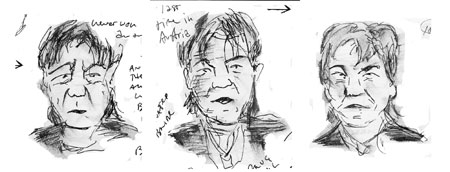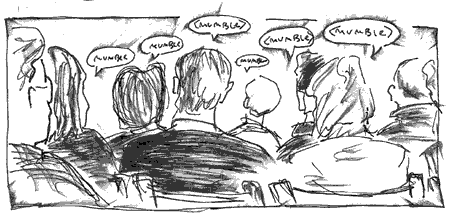
THE AUDIENCE
“World domination through bake sales,” Ellen Klages said. “That’s our goal: world domination. And if there are any homeland security folks here tonight, I can spell that for you.”
At the end of the most beautiful day of the year, Klages and Maureen Mchugh read at Mac’s Backs last night in celebration and promotion of the James Tiptree Award Anthology 2: Sex, The Future, and Chocolate Chip Cookies. Klages is on the Tiptree board, and McHugh’s first novel, China Mountain Zhang, received the award in 1992. For those of us ignorant of James Tiptree Jr., Klages began with the fascinating story, which included secret identities, gender reversals, jealousy, betrayal, and other steamy stuff you can read about here.
“If you know someone who says, ‘Oh, I don’t read science fiction’, send them to the Tiptree website and tell them to get started,” Klages said. “They won’t be disappointed.”

“Last time I was here, I found out Dan Chaon and I watch the same trash TV,” McHugh said. “Tonight I’m going to steal one of his ideas, and read a story that isn’t finished. Maybe you can give me suggestions for the ending.”
The story was inspired by a phase one drug trial in England that went terribly wrong. There were eight healthy participants in the room: six were given the drug, and two were given placebos. “The first man said, ‘Oh God, I’m so hot,‘ tore off his shirt, and dropped to the ground. Two minutes went by, and another man said, ‘I’m going to vomit,’ and dropped. So one man is standing there thinking, ‘Well, maybe I got the placebo.’ The drama of the situation! And I’m thinking, what kind of person would choose to do this to themselves?“
Maureen read the first 2,000 words, beginning with the sentence, “I was an aggravated bride.” The Bride is from Lancaster, Ohio, and has moved to Cleveland to work at the Clinic. Her life is full of McDonalds and craft shows. The story begins when her new husband’s Ford F-150 breaks down, and he tells her he has gambled their honeymoon money away in Windsor. Eventually, she decides to make some easy money…and that’s where the 2,000 words ended.
I asked Maureen afterwards when was the last time she was in Lancaster.
“I used to go to school in Athens,” she said. “That’s how I know it’s pronounced ‘Lang-caster’ instead of Lan-caster.”
I told her that Lancaster was our getaway in high school. In a twangy voice, “We use’ta get in the truck, put on the tape, and drive to Lancaster!”
And that’s what I love about her stories and hope for in mine–she takes ordinary folks from Ohio and puts them in extraordinary situations.

ELLEN KLAGES
Ellen’s reading made me a little sad because I only met her a month ago, and in two weeks she’s moving to San Francisco. “I feel like Captain Von Trapp,” she joked. “Tonight will be my last performance in Austria.”
Her great story, “Ringing Up Baby,” is coming out soon in NATURE magazine. It’s about a girl in the future who gets to choose her new sibling: gender, hair color, and all.
And for all the talk about women and gender in the fiction, something fantastic was happening during the reading. I can’t remember feeling warmer at a literary event. There were cookies to eat (McHugh makes a fantastic cookie with rosemary), books for sale, temporary tattoos, and a tip-Tree jar. No ego in sight, just two wonderfully talented and inviting women sharing their storytelling talents.









